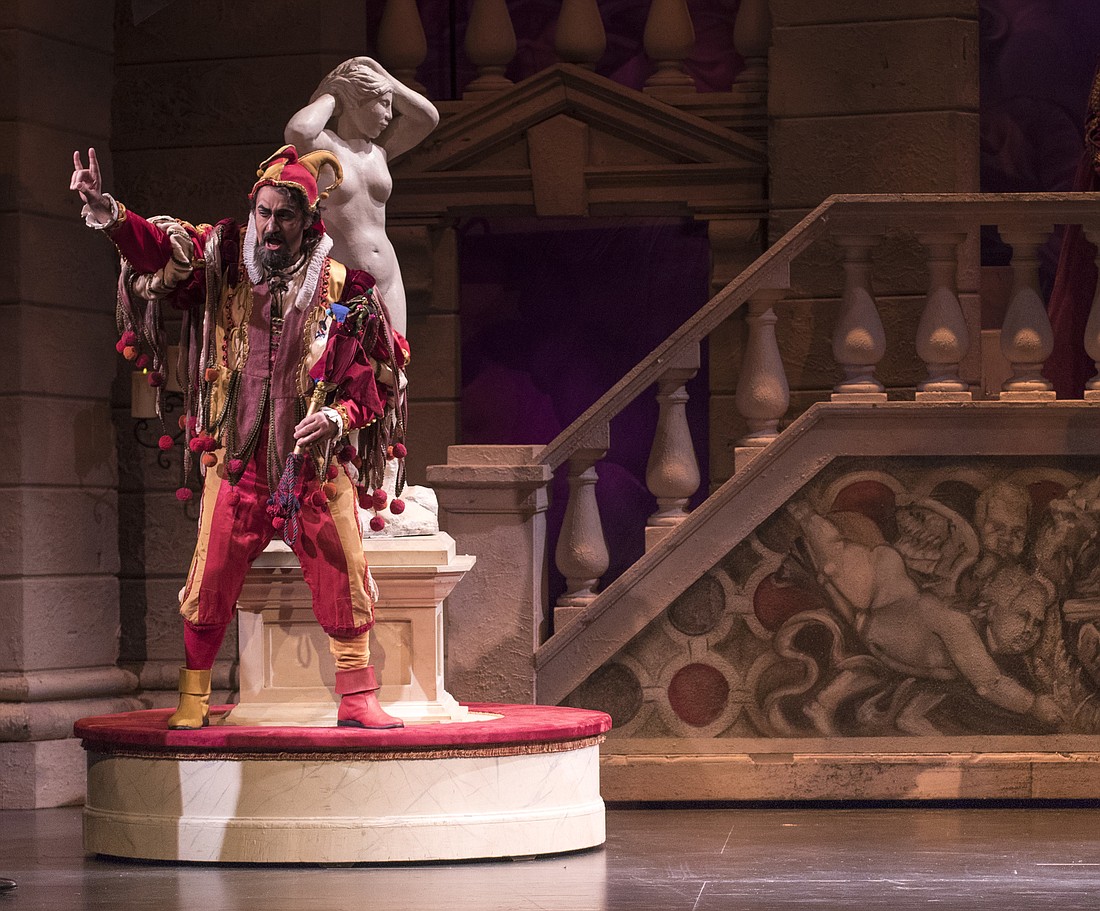- April 22, 2024
-
-
Loading

Loading

The Sarasota Opera opened the 2019-20 season with Giuseppe Verdi’s “Rigoletto” in its fourth presentation in the Sarasota Opera House. I’ve been fortunate enough to see all four and witness firsthand the artistic progress of the company through the years. This production is yet another step forward.
The first was in 1989, which turned out to be the beginning of the “Verdi Cycle,” in a deliberately old-fashioned production complete with painted scenic drops, footlights and stylistic acting. In that era, the large chandelier was still hanging in the Opera House lobby, and the balcony had not yet been opened for occupancy. Among the singing apprentices in 1989 was tenor Richard Russell, now the executive director of the Sarasota Opera.
The second in 2008 featured sets designed by David P. Gordon for the grand reopening following the $20 million renovation and restoration of the Opera House and was again presented in fall 2012.
“Rigoletto” was a product of Verdi’s middle period, in which he was beginning to depart from the “aria, ensemble, aria” style of earlier operas and is in many ways an opera of duets, which gives him more opportunity to explore the emotions and thoughts of his characters. It also involves once again the tortured feelings of a father’s intense love for his daughter, a theme present in so many of Verdi’s operas, likely inspired by the fact that by his 27th year, Verdi had lost both of his children and was a widower.
After a slightly shaky start with a few coordination problems in the chorus between stage and pit, the performance settled in and got down to the business of this tragic opera and the father’s curse placed on Rigoletto by Monterone, which was forcefully sung by studio artist Alexander Charles Boyd.
Marco Nisticò’s Rigoletto is clearly a man of conflicting emotions: He deeply resents playing the buffoon for the duke, who is constantly out for new conquests, and he gives vent to these feelings with his vitriolic humor and goading of the courtiers. All the more reason for his fierce protection of his daughter, Gilda. Nisticò conveys all these feelings quite effectively, and although he had some occasional vocal issues, he was quite convincing both vocally and dramatically. His voice displayed the anguish and grief of a father whose entire life is his daughter.
William Davenport’s Duke of Mantua is a big burly scoundrel who toys with every female he desires, which is every female he sees. His lyric tenor shone forth in the arias, but he was most effective in the touching duet with Gilda, which ended in a lovely double cadenza.
Clearly, the vocal highlight of the opening night’s performance was the limpid singing of Hanna Brammer as Gilda, the lonely and somewhat naive daughter of Rigoletto, who sacrifices her life out of her love for the lecherous duke. She has a crystal-clear sound coupled with flexibility, which enables her to handle musical challenges with ease. Her aria “Caro Nome” was simply beautiful.
Young Bok Kim returned to the role of assassin Sparafucile, with his forceful and virile bass adding proper menace to his role. He was aided by his seductive sister, Maddalena, well sung and acted by Annie Chester, whose warm and burnished mezzo sound certainly worked its magic on the duke.
Verdi’s “Rigoletto” contains at least two of opera’s greatest hits: “La donna e mobile” — the duke’s aria about the fickleness of women — and the great quartet from the last act.
In the quartet, each of the characters conveys a different emotion: the duke’s seduction, Maddalena’s teasing, Gilda’s despair and Rigoletto’s consolation. In opera, through music, we’re able to understand the feelings of each character, though all are singing at once. That could never be accomplished in spoken theater. It was given a splendid performance by all four singers.
Stephanie Sundine’s excellent direction kept the action moving in a most believable fashion, contrasted with lovely moments of repose.
Smaller roles were taken by studio artists Michelle Blauman as Giovanna, Gilda’s duenna; Joshua DeVane as Marullo; Samuel Schlievert as Borsa; Christopher Nazarian as Count Ceprano; Caitlin Crabill as his wife, the Countess; and Kathryn Domyan as the page. Apprentice artist Brent Hetherington was a court usher.
All were beautifully costumed by Howard Tsvi Kaplan, who no doubt had his choice from the newly acquired costume stock of the Sarasota Opera Costume Collection. Beautiful costumes all.
Gordon’s sets have been beautifully refurbished and are lit by Ken Yunker, whose lighting is almost musical in its fluidity. Especially effective were the larger-than-life-size portraits of the duke and duchess in act two.
The excellent chorus of apprentice and studio artists was trained by Lindsay Woodward, and Tania Vergara’s choreography provided most appropriate dances for the festivities of the first scene, quite an achievement given the space limitations on stage.
It’s always a pleasure to have the Sarasota Orchestra in the pit for these fall productions, and the musicians provided a beautiful accompaniment at all times. Artistic Director Victor DeRenzi conducted an excellent and thoughtful performance. DeRenzi is a Verdi scholar, and no doubt he consulted the critical edition of this opera, as well as other sources, to be sure it was authentic in every way.
There might have been a few opening night glitches, but they were few and far between and will have disappeared in future performances. This is an excellent production of one of the most popular of all operas. So popular in fact that at pre-performance dinner, someone said they already had tickets for three performances and might see a fourth. And that is a strong endorsement if I’ve ever heard one.